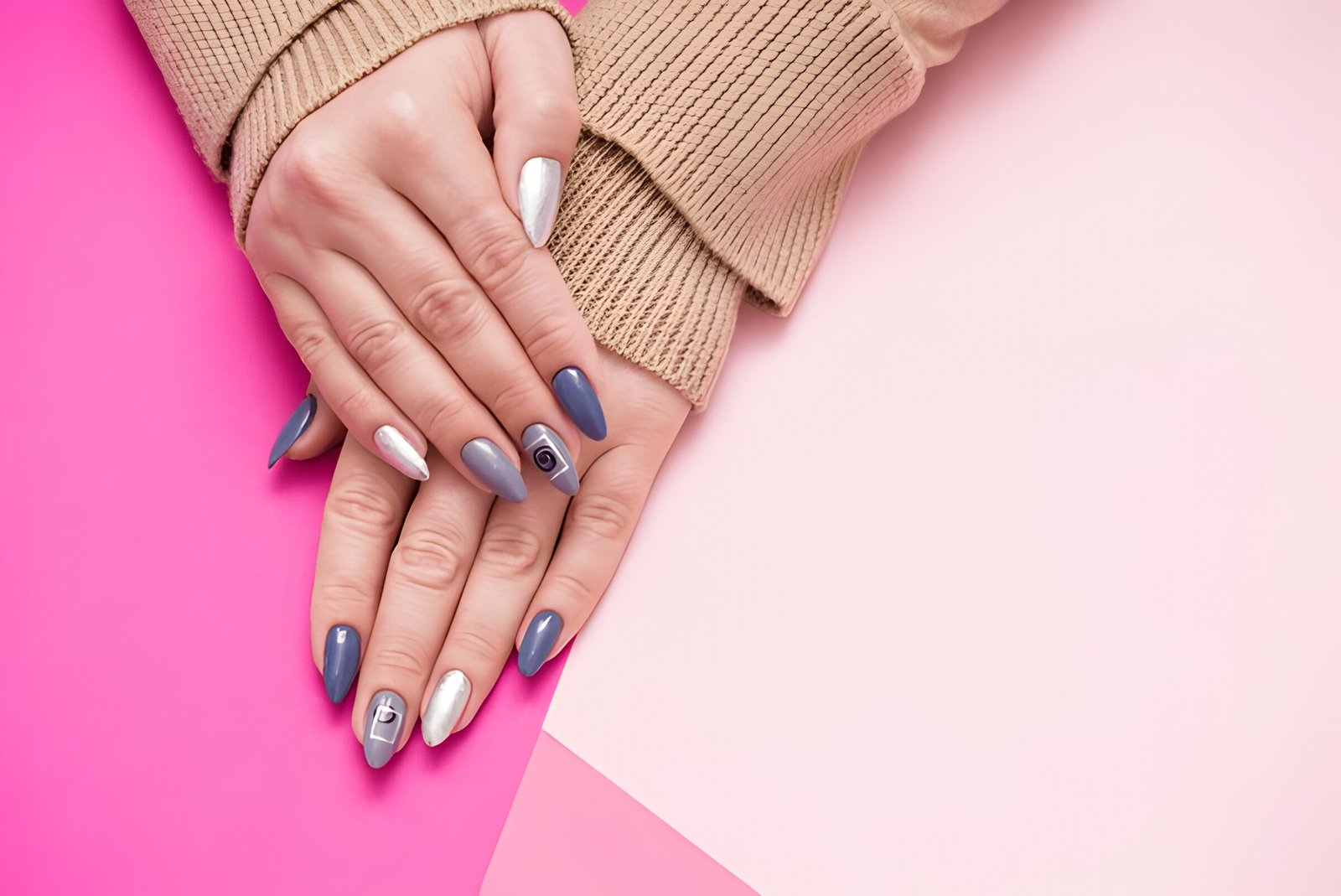Image Credit : Shutterstock
Polygel nails have taken the nail art world by storm, offering a perfect blend of durability and flexibility. This innovative nail enhancement technique has gained popularity among both professionals and DIY enthusiasts, thanks to its ease of application and stunning results. With polygel, achieving salon-quality nails at home has become more accessible than ever, allowing individuals to experiment with various nail shapes, designs, and colors.
This guide will walk readers through the essentials of applying polygel nails, starting with the must-have items in a polygel nails kit. It will cover how to prepare natural nails for the best results, provide a detailed step-by-step process for applying polygel, and share tips on finishing touches and maintenance. Whether you’re a beginner or looking to refine your skills, this article will equip you with the knowledge to create beautiful, long-lasting polygel nail designs from the comfort of your home.
What You’ll Need: Essential Polygel Nail Kit Components
To achieve beautiful polygel nails at home, one needs a comprehensive kit with essential components. A typical polygel nail kit contains several key items that enable users to create salon-quality nail extensions, such as those offered by Whitchurch Nails. Here’s a breakdown of the essential components:
Polygel
The star of the show is the polygel itself. This innovative product comes in tubes and is available in various colors, including clear, white, pink, and nude shades. Polygel combines the durability of acrylic with the flexibility of gel, making it ideal for nail extensions. A pea-sized amount is usually sufficient for each nail.
Dual Forms
Dual forms are crucial for shaping the polygel and creating nail extensions. These curved plastic molds come in different sizes to fit various nail shapes and sizes. They help in achieving the desired length and shape of the nail extension.
UV/LED Lamp
A UV or LED lamp is essential for curing the polygel. Most kits include a lamp with multiple timer settings, typically 30 and 60 seconds. The lamp hardens the polygel, setting it in place and creating a durable nail extension.
Base and Top Coat
A base coat is applied to the natural nail before the polygel to ensure better adhesion. The top coat is used after the polygel application to seal and protect the nail extension, giving it a glossy finish. Some kits offer a “no-wipe” top coat, eliminating the need for cleaning the tacky layer after curing.
Nail File and Brush
A nail file is necessary for shaping and smoothing the cured polygel. Many kits include a dual-ended tool with a brush on one end and a spatula on the other. The brush, often used with a slip solution, helps in shaping and smoothing the polygel before curing.
Additional items in a comprehensive kit may include:
- Cuticle pusher and scissors
- Nail dehydrator and primer
- Slip solution (often 91% isopropyl alcohol)
- Nail tips (if not using dual forms)
- Cuticle oil for aftercare
With these essential components, anyone can start creating professional-looking polygel nails at home. The process requires practice, but with the right tools, achieving salon-quality results becomes much more accessible.
Preparing Your Natural Nails for Polygel Application
Proper preparation of natural nails is crucial for achieving long-lasting polygel nail extensions. This process involves several steps to ensure the nail surface is clean, smooth, and ready for product application.
Pushing back cuticles
The first step in nail preparation is to address the cuticles. One should gently push back the cuticles using a metal or wooden cuticle pusher. After pushing back the cuticles, one can use the corner of the cuticle pusher to scrape off any dead skin from the nail surface. This ensures that the polygel adheres directly to the nail plate and not to dead skin, which could lead to lifting.
Filing and shaping nails
Next, one should focus on shaping and smoothing the natural nails. Using a 100/180 grit nail file, gently file over the natural nail with the smoother side. This process removes the shine from the nail surface, creating a better base for product adhesion. Special attention should be paid to the cuticle area, sidewalls, and free edge of the nail to prevent lifting.
If desired, one can trim the nails to the preferred length using nail clippers before shaping. The nail file can then be used to refine the shape, whether it’s square, round, or any other preferred style.
Dehydrating the nail plate
The final step in nail preparation involves thoroughly cleaning and dehydrating the nail plate. This is crucial for removing any remaining oils or debris that could interfere with product adhesion.
- Use an alcohol nail pad or nail surface cleanser with a lint-free wipe to remove all dust and oils from the nail surface.
- Apply a layer of nail prep or nail dehydrator to the nail plate. This product helps to remove any remaining moisture and creates an optimal surface for polygel application.
- Some nail technicians may also use a primer after the dehydrator for enhanced adhesion, especially if recommended by the polygel brand being used.
By following these preparation steps, one creates an ideal foundation for polygel application, helping to ensure a durable and long-lasting nail enhancement.
Step-by-Step Polygel Application Process
Applying base coat
The process begins with applying a thin, even layer of gel base coat to all nails. This step is crucial for enhancing adhesion and providing a surface for the polygel to grip. After application, the base coat should be cured for 30 seconds in an LED/UV nail lamp.
Shaping polygel on dual forms
- Select the appropriate dual form size for each nail, ensuring it fits from sidewall to sidewall.
- Squeeze a small amount of polygel into the dual form.
- Dip the brush into slip solution (often 91% isopropyl alcohol), tapping off excess.
- Gently pat and shape the polygel in the form, creating a thinner layer at the cuticle and tip, with a thicker middle for the apex.
- Press the form onto the nail, starting at the cuticle area and moving towards the tip.
- Smooth out the underside to create an even tip and remove air bubbles.
Curing and removing forms
- Ensure the dual form is straight on the nail before curing.
- Cure the polygel for 30 seconds in an LED/UV lamp.
- After curing, gently wiggle the form side to side using the tabs.
- The form should pop off easily, revealing the shaped polygel nail.
Filing and shaping cured polygel
- Use a lint-free wipe with rubbing alcohol to remove the tacky layer from the underside of the nails.
- File the free edge to perfect the desired shape (e.g., almond, square).
- Smooth the surface of the nails, paying special attention to the cuticle area and apex.
- File carefully and check progress frequently to avoid over-filing.
- Ensure the cuticle area is flush with the natural nail to prevent lifting.
- Clean off any dust and wash hands to remove excess product from skin and nails.
After completing these steps, the polygel nails are ready for the final touches, including top coat application and any desired nail art or decorations.
Finishing Touches and Maintenance Tips
Polygel nails have revolutionized the world of nail art, offering a perfect blend of durability and flexibility for both professionals and DIY enthusiasts. This guide has walked you through the essentials of applying polygel nails, from gathering the right tools to mastering the application process. With practice and patience, you’ll be able to create stunning, long-lasting nail designs from the comfort of your own home.
Remember, the key to beautiful polygel nails lies in proper preparation and technique. By following the steps outlined in this guide and experimenting with different colors and designs, you’ll be well on your way to achieving salon-quality results. So grab your polygel kit, fire up that UV lamp, and let your creativity shine through your fabulous new nails!
FAQs
1. How can beginners apply PolyGel nails step-by-step?
To apply polygel nails at home, start by filing your nails to prepare the surface. Next, select the appropriate dual or nail forms that fit your fingers. Apply a base coat and cure it under an LED light. Then, dip your brush in a slip or alcohol-based solution and squeeze the polygel onto the dual form or nail.
2. What is the best way to ensure PolyGel is applied smoothly?
To apply PolyGel smoothly, ensure that your brush is properly dipped in a slip solution or an alcohol-based alternative. This will help in spreading the PolyGel evenly on the nail form or directly on the nail.
3. What should be done to nails before applying PolyGel?
Before applying PolyGel, it is crucial to prepare your nails by buffing them, cleansing the surface, and dehydrating them. This preparation helps the gel base coat adhere firmly to your nails once it is cured.
4. What alternatives can be used if slip solution for PolyGel is unavailable?
If you do not have a slip solution, you can use 70% isopropyl alcohol as an effective substitute. Dip your brush in the alcohol to achieve a smooth application of the Poly Nail Gel. Isopropyl alcohol is commonly available at pharmacies or online stores.




